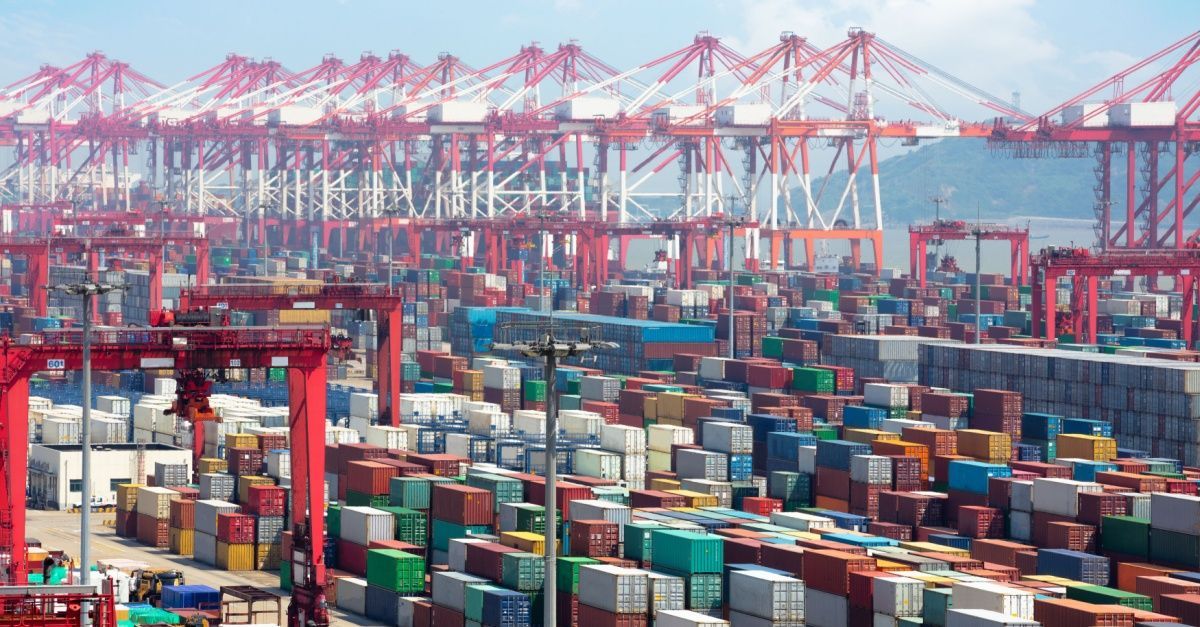What Is the OTIF Definition in Logistics & Why Are Shippers Focused on It?
Blog Post CTA
What Is the OTIF Definition in Logistics & Why Are Shippers Focused on It?
To get to the bottom of the leading disruptions associated with COVID shutdowns and restrictions, shippers, carriers, brokers, and drivers must understand on-time in-full definition and its impact on supply chain logistics. The leading cause for the losses experienced by retailers and suppliers today is shortages in supply and the unavailability of a range of products- from toilet paper to food and drinks to medications.
Delays caused by poor driver services, loading and unloading issues, and lack of drop and hook access, among others, continue to plague modern supply chain logistics. Understanding the answer to what OTIF means and what current OTIF definitions entail is vital because if items are out of stock or otherwise unavailable and inaccessible, it hurts shippers, retailers, and customers alike. Some innovations have made it easier to understand OTIF meaning related to expedited freight shipping services.
What Is On-Time In-Full Delivery?
Understanding the intricacies of what is OTIF in the supply chain network and developing a unified OTIF definition seems obvious. But far too many shippers do not have a firm grasp on this critical metric. On-time in full delivery is a measurement of logistics or delivery performance within a supply chain logistics plan. It most often is presented as a percentage success rate. For example, achieving a 90% OTIF delivery success for orders to a particular customer, location, or load type is a common standard among shippers. The OTIF definition used, however, can significantly impact how these percentages end up calculated, especially when dealing with oversized and overweight freight and other specialty cargo logistics.
What Does OTIF Mean For Supply Chain Managers?
Looking at the various ways companies and network leaders can approach questions about OTIF meaning brings to light the importance of networking and transparency. Shipping and supply chain logistics companies are no longer confined to the 'walls' of their company or partner networks. It is a small, digital and global world, and the supply chain is no different. Brick and mortar shops are not dead, but they are far from the clear choice they were decades ago. Times change, and shippers and logistics managers who are unable or unwilling to adapt will ultimately struggle to keep up with the changing focus of consumers.
In an early 2022 article on OTIF definition,
SupplyChainBrain noted that “corporations have moved from vertically integrated to incorporating a horizontal network of global trading partners. This trading partner ecosystem typically represents more than 80% of the manufacturing, distribution, and logistics capacity of the products produced for the end consumer.” Knowing what industry-specific OTIF definitions are references and answering the question of ‘what is OTIF for a specific shipment or industry' is vital to maintaining a competitive advantage in a highly volatile market and
optimizing transportation.
OTIF meanings and definitions significantly impact key supply chain metrics, the Perfect Order Proficiency percentage. Shippers and customers alike will use this and other metrics to gauge the success of delivery and shipment services. Therefore, having a keen understanding of OTIF definitions makes continued growth and winning more attainable.
The Impact of OTIF definitions — Beyond Delivery Success
OTIF meaning for retailers and express shipping providers remains so impactful because successful on-time in-full delivery means that the product is on the shelf when it needs to be. This means delivery and availability for some products and goods when consumers are ready to buy. For others, a delivery arrives when and where the end customer requests.
Lost Revenue Offsets Successful Delivery
Lost revenues due to poor delivery and drop-offs could significantly impact profitability and substantially increase the operation and shipping costs. When working with one OTIF definition, it is essential that all involved trucking service providers stay on the same page and use the same metrics to answer the question — what does OTIF mean?
To see the importance of a good understanding of OTIF definition in general, shippers need only look at how losses and fees on one order can quickly add up if duplicated over multiple orders and customers on a monthly, weekly, or even daily basis. Unlocking the ultimate value of OTIF delivery is not easy for various reasons, including lack of visibility, poor network insight, a lack of collaboration, and insufficient automation.
supply chain complexity increases with the proliferation of new supply chain technology focused on tracking and monitoring cargo. What is OTIF? The answer can be challenging to answer with many factors to consider and consider.
Lack of Uniformity in OTIF meaning is a Breeding Ground for Disruptions and Complications.
When considering OTIF meaning in logistics, supply chain complexity and volatility must factor into goals and milestones. The pressures felt within the supply chain network continue to rise as customers demand a more comprehensive selection of products, a broader choice of shipping channels, and more promotional offers. Foodservice, reefer freight, and refrigerated transport significantly impact OTIF meaning and definition across nearly all industries. To overcome these disruptions and complications in today's industrial markets, freight management parties must take a new approach to on-time delivery markers.
Expectations and Demands Remain High as Always
According to Mckinsey & Company, “with expectations of higher on-shelf availability and lower inventory costs, the pressure on delivery performance has intensified—as requires manufacturers, retailers, and carriers to work together to create efficient, reliable, and responsive supply chains." This is possible with reliable, on-time, in-full cargo and freight delivery. So, figuring out what is OTIF and its parameters should be pretty straightforward, right? Unfortunately, it is not a clear answer as there currently is no standard definition for OTIF within any supply chain network or across multiple industries.
Different supply chain participants may set their guidelines and parameters. In addition, even if they use the same general metrics, they often are free to interpret them in significantly different ways. Not having a unified way to address the OTIF meaning dilemma can greatly intensify disruptions, miscommunications, and waste of food service resources.
When different parties approach the same topic or goal differently, it is hard to agree to even the most straightforward standard ground parameters. Does "on-time" mean delivery when the manufacturer first promised the goods or when the shipper said it would arrive? Does it mean within a narrow delivery window or a broader, more flexible estimated timeframe? Should "in-full" tell 100% of the order was delivered successfully, more than 85%, or another measurement? How do current reefer freight shipping quotes relate to OTIF success rates and guarantees? These are just some of the questions that arise and need answering because there is no clear way to summarize OTIF definition within the transportation industry.
Towards the end of 2021, Global Trade Magazine stated in a review of supply chain delivery metrics and OTIF meanings that “over the course of 2021, a growing number of headlines have predicted or even called for the demise of 'Just-In-Time,' the system that evolved from Toyota's approach in the 1970s to minimize inventory and increasing efficiency. The underlying argument is that businesses would have fared much better during recent supply chain disruptions had their supply chains been less lean." These points are well worth considering as their impact can be significant for short-term and long-term supply metrics.
Effective supply chain collaboration depends upon a precise, shared understanding of delivery-performance expectations. Today's diversity of approaches means partners waste time arguing over the figures rather than addressing the root causes of delivery issues. The importance of answering the question of 'what does OTIF mean’ has more far-reaching impacts than most realize.
Why a Standard OTIF Definition Matters
The chosen OTIF definition sets the tone for everything else involved within a company’s approach to shipping services and customer relations. Organizations today know the value of maintaining a customer-centric focus and the importance of end-customer services. Adjusting services and tailoring supply chain logistics and operations to serve customers better, meet shifting market demand, and improve on-time, in-full deliveries must remain a priority. This is especially true in the reefer trucking, climate-controlled, refrigerated transportation market.
However, achieving this means having goods available, streamlining communications and disruption responses, keeping customers informed of the progress of their orders, and ensuring a smooth and successful delivery experience. In the best of times, drawing in new customers is complex, and keeping them can be an even more significant challenge. With current market volatility and disruption levels, this difficulty only intensifies. Selection and adhering to a specific OTIF meaning becomes a challenge when customers frequently change focus and demand more from transportation service providers.
A standard OTIF definition makes it easier to address the industry’s supply delivery issues by providing benefits in several ways:
Creating a Common View and Approach For OTIF Meaning
While the question of ‘what is OTIF’ may seem straightforward, industry leaders have taken many approaches to find a workable answer. Many retailers and manufacturers currently calculate OTIF in different ways. That gap means that even when multiple supply chain participants come together to review data and discuss performance metrics, the same steps and methods will yield different results.
As highlighted by Forbes, “in a world struggling to recover from COVID-19, intelligent technologies like IoT, machine learning, and AI are transforming supply chain logistics, and quality assurance for groundbreaking innovations…” and a unified OTIF meaning universal delivery parameters only improve delivery success. IoT-based delivery tracking and scheduling metrics capture multiple critical parameters for delivery. It is all accomplished with real-time metrics and integrations, using machine learning and AI algorithms to automatically monitor shipments and alert team members of possible disruptions and exceptions. This is important with any load but is essential when dealing with temperature-controlled freight.
With unbalanced OTIF definitions, retailers and manufacturers devote significant time to explaining and reconciling differences in reported data. Carriers are often caught in the middle, as retailers and manufacturers push them for improved performance based on inconsistent data and requirements. Something has to change for continued growth and success in the short-term and long-term.
Unravel the Intricacies of On-Time In-Full Delivery Parameters
The effort required to reach a consensus on a unified OTIF meaning and correct performance measurement and performance issues represents a common roadblock for shippers. Establishing and maintaining a standard for OTIF requirements will help ensure a more significant focus on collective effort to drive overall improvement for TL, LTL, and other specialty logistics.
A thorough method for establishing OTIF definitions will support supply chain performance and strengthen the consumer-focused approach in three ways, as highlighted by McKinsey & Company:
- Aligning service expectations gives companies more confidence throughout the process of setting and committing to delivery parameters and customized services.
- Improves delivery performance management, giving partners a common starting point and basis to gauge all performance targets against boost delivery performance.
- A unified OTIF meaning will enable performance benchmarking while also improving the development of benchmarks in general for enhanced industry-wide comparisons.
The standardizing process of OTIF is essential so everyone speaks the same language and does not unintentionally give misinformation to customers, team members, food service
freight brokers, or other delivery partners.
Reducing supply chain Complexity of OTIF Definitions
The absence of a standard definition and understanding of OTIF meanings complicates supply chain management for manufacturers and retailers. Establishing dedicated freight solutions and logistical planning remains critical for supply chain managers and shipping logistics team members. Because each retailer has a different purpose, shippers, suppliers, and manufacturers must meet various delivery standards and meet individual definitions and expectations for on-time, in-full delivery that can be vastly different. Even the significant retailers use other purposes, and their intentions keep evolving and changing. Hence, it only adds to the complexity and struggle of maximizing OTIF supply chain logistical planning and overall operations.
Shipping and delivery demands have repeatedly pushed supply chain changes in first and final mile delivery. The experts at SupplyChainDive pointed out that “improving supply chain performance — and finally hitting the tantalizing 90% OTIF — begins and ends with improving supplier relationships and performance. It’s the only way to truly account for changes in the supply chain that are as constant as they are guaranteed.” The challenge is finding a uniform way to report these improvements and OTIF rates. Results often vary greatly, depending on product type and what OTIF definition was used during any particular calculation or write summary within specific trucking companies.
Reducing Cost Impacts and Lost Opportunities
OTIF meaning and adherence also impact shippers and retailers' financial stability and profitability. Manufacturers must keep track of changing OTIF definitions because retailers impose financial penalties for noncompliance. This leads to a loss of profits and a decline in repeat and new customers.
Aside from immediate financial impacts from fees and surcharges, the loss of income from poor OTIF delivery rates can be devastating to produce and reefer transportation companies. When shippers try to answer the question of what does OTIF mean, it is vital that short-term and long-term financial effects are considered carefully and weighed seriously as factors affecting on-time in-full parameters for everything from produce shipping to other food and beverage freight considerations.
Disparate Definitions and Separate OTIF Meanings Cause Continued Confusion
The final issue that a lack of unified OTIF definitions brings is the level of confusion that permeates the network and impacts nearly every aspect of delivery services. Confusion surrounding OTIF meanings and guidelines leads to higher expenses for shippers, whether they come from fees required to compensate for missed delivery guarantees, lost cargo and customer-returned loads, or a decline in customer retention. To avoid those charges, manufacturers face the challenge of making improvements and innovations to boost overall OTIF supply chain logistics services and address ongoing issues with delivery drop-offs.
In early 2022, The OSJ released a report that in part stated, "since the World Health Organization’s (WHO) declaration of the COVID-19 pandemic, borders around the world have been deeply impacted, and Customs administrations, transport authorities, and the railway sector are doing their part to prevent and fight the spread of COVID-19 while trying to safeguard supply chain continuity.” This brings to light another aspect of the struggle shippers face when dealing with discrepancies and differences in OTIF definitions. It creates undue confusion among involved cold freight shipping partners.
Without proper guidance and insights, many shippers, retailers, manufacturers, and team members run around in circles trying to force approaches and processes that have not been vetted or are doomed to failure. This leads to extra complexity and an overall reduction in supply chain efficiency, which further hinders shippers and adds more uncertainty to the struggle to define OTIF meaning for full truckload drivers in the supply chain network.
Answering the Question of What Does OTIF Mean Through Effective Collaboration
Collaborative efforts with multiple industry experts across many modes and transportation specializations have given rise to a few potential breakthroughs in the debate over selecting a single, unified OTIF meaning. As highlighted by SupplyChain247, “Requirements for [some] shipments have been made more stringent as well. CPG companies are having trouble keeping up, with compliance reported to have reached only 70% by August 2017. The accumulating fines show that the usual short-term measures and localized interventions have not been enough." Progress has been made, but there is more work to reach a unified and more broadly accepted way to get a consensus on OTIF meanings today. Experts who have worked on the issue and see the effects of disparate guidelines suggest the following working OTIF definition:
Cargo delivered to the intended destination by the listed delivery date is calculated as a percentage of the ordered quantity. This definition would handle most real-world scenarios, including specialty deliveries involving drop-trailers, full and less than full trailers, intermodal, and rush orders, all in three basic steps.
- Any over-delivered quantity or incorrect product shall be disregarded for or against the OTIF resting. In other words, delivering 500 items rather than the requested 400 will not negatively impact the on-time in-full rating.
- Arrival at the destination facility counts as the arrival time for the OTIF designation. This is a change from many current modes that use actual unload or load check times, which often experience delays outside management’s control.
- The requested delivery window should not penalize shippers for making delivery a little earlier. It is usually better to receive cargo a little early than a little late, especially with perishable goods, so a one-day early delivery should be allowed.
Find an All-Encompassing Method of Understanding OTIF Meanings and Improve Supply Chain Coordination With a Clear OTIF Definitions
While they might seem of little value at first glance, how OTIF definitions are established and maintained can significantly impact the supply chain with reefer and temperature-sensitive freight management and logistics. Today, choosing a uniform way to control OTIF meaning and to monitor, in real-time, delivery success rates often means rethinking the way OTIF supply chain deliveries are handled.
Shippers may have to combine multiple modes and shipping methods to secure OTIF ratings while juggling the seemingly ever-changing way companies and businesses approach OTIF definition and compliance. When dealing with reefer, produce, and frozen freight, the attention to detail from pick up to delivery are more important than ever.
Partnering with industry experts can save time, money, and resources through more effective management and logistical planning for expedited shipments. Having uniform and cohesive plans and procedures and a unified definition for on-time, in-full compliance rates simplifies the entire delivery process. With a clear focus and understanding of supply chain logistics, such as those unique industries like food and beverage, a rethinking of standard OTIF meanings, and a commitment to improvement across the network, shippers can improve on-time in total success rates and delivery term compliance.
Faster and more effective processes benefit the entire supply chain and logistics network. It is all possible with insight and guidance from industry experts. Contact Entourage Freight Solutions today to learn more about improving OTIF supply chain compliance within the foodservice industry through better freight management.









